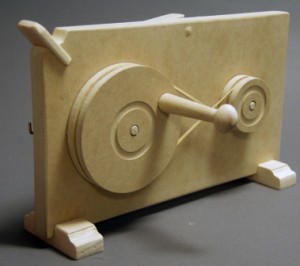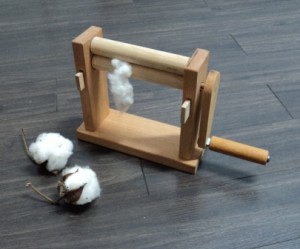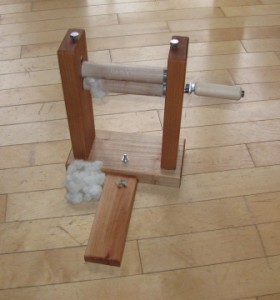Capacity: 5-10 lbs (2-4 kg) Seed Cotton per Day Power: Hand Operated Net Weight: 6.6 lbs (3 kg) Height: 12 inches Width: 10 inches
History, Invention, Significance and Uses of Cotton Gin
The Cotton Gin is a machine designed to separate the seeds from the cotton harvested from the plant. The process uses a small screen and pulling hooks to force the cotton through the screen. It was invented by Eli Whitney on March 14, 1794, one of the many inventions that occurred during the American Industrial Revolution. The cotton gin is a machine designed to separate the seeds from the cotton harvested from the plant. The process uses a small screen and pulling hooks to force the cotton through the screen. The cotton gin made the cotton industry of the south explode. Previous to its invention, separating cotton fibers from its seeds was a labor-intensive and unprofitable venture. However, after Eli Whitney unveiled the cotton gin, processing cotton became much easier resulting in greater availability and cheaper cloth. However, the invention also had the by-product of increasing the number of slaves needed to pick the cotton thereby strengthening the arguments for continuing slavery. Cotton as a cash crop became so important that it was known as King Cotton and affected politics up until the Civil War. After the invention of the cotton gin, cotton became America’s leading crop. Cotton was king. In 1790, America produced 1,500 pounds of cotton. By 1800, production had increased to 35,000 pounds. By 1815, production had reached 100,000 pounds. In 1848, production exceeded 1,000,000 pounds. Simultaneously, slavery spread across the Deep South. In 1790, the slave population was concentrated in Virginia on the tobacco plantations and along the coast of South Carolina and Georgia on the rice plantations. In 1820, slavery had spread westward to Mississippi. By the Civil War, about 4 million slaves lived in the South. Although the invention of the cotton gin changed history, its inventor, Eli Whitney, did not reap much of a profit. The gin made cotton cleaning so efficient that the crop became a primary enterprise for the South. However, patent disputes and supply problems kept Whitney from successfully producing the cotton gin. The role of the cotton gin has changed dramatically in the last 50 years to keep up with technological and production changes in the cotton industry. At one time, the gin’s only function was to separate cottonseed from fiber. Today, gins must not only separate the seed from the fiber, they must also dry and clean the fiber and package it into bales before it reaches the textile mill. All gins differ in some aspects of the ginning process. In the Southwest, for instance, gins are equipped with both saw and roller gins: saw gins for ginning Upland cotton, and roller gins for ginning Pima cotton, cotton grown almost exclusively in this region of the Cotton Belt. Elsewhere in the Cotton Belt, gins use only saw gins in their operation. Below are some of the gins we offer for sale for your educational projects, spinning projects, and scientific experiments. If you are interested in buying any of these cotton gins, please contact us.
Eli Whitney Model Gin
A simplified model of Eli Whitney’s cotton gin. Assembly required Net Weight: 2 lbs (900 g) Length: 11 inches Width: 6.25 inches Height: 3 inches
Roller Gin Demo Gin
Demonstration model gin ideal for schools, education and classroom projects. Does not gin cotton but is a great educational tool for educators and teachers Net Weight: 1.3 lb(600 g) Length: 9 inches Width: 3 inches Height: 7 inches
Ginny (hand-cranked cotton gin)
Wheel Gin (hand crank)
Click to view video for wheel cotton gin in action.
For Price list, distribution or any other information about the Cotton Gin, Contact Us





